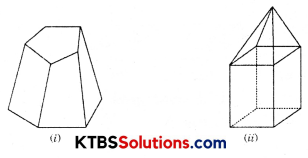You can Download KSEEB Solutions for Class 8 Maths Chapter 10 Visualizing Solid Shapes Ex 10.3 Questions and Answers helps you to revise the complete syllabus.
KSEEB Solutions for Class 8 Maths Chapter 10 Visualizing Solid Shapes Ex 10.3
Question 1.
Can a polyhedron have for its faces
(i) 3 triangles?
(ii) 4 triangles?
(iii) a square and four triangles?
Solution:
(i) A polyhedron cannot have three triangles for its faces.
(ii) A polyhedron can have four triangles for its faces.
(iii) A polyhedron can have a square and four triangles for its faces.
![]()
Question 2.
Is it possible to have a polyhedron with any given number of faces? (Hint: Think of a pyramid).
Solution:
Yes, it is possible only if the number of faces is greater than or equal to four.
Question 3.
Which are prisms among the following?

Solution:
(i) A nail is not a prism.
(ii) An unsharpened pencil is a prism.
(iii) A table weight is not a prism.
(iv) Yes a box is a prism.
![]()
Question 4.
(i) How are prisms and cylinders alike?
(ii) How are pyramids and cones alike?
Solution:
(i) A prism becomes a cylinder as the number of sides of its base becomes larger and larger.
(ii) A pyramid becomes a cone as the number of sides of its base becomes larger and larger.
Question 5.
Is a square prism the same as a cube? Explain.
Solution:
A square prism is made up of two parallel end faces, each one of which is a triangle and three lateral faces, each one of which is a square. In a cube, its faces are congruent, regular polygon. Vertices are formed by the same number of faces. Thus, a square prism and cube have a square of its base. Clearly, their bases are square. Hence prism and cube are the same.
![]()
Question 6.
Verify Euler’s formula for these solids.

Solution:
(i) In this figure,
F = 7, V = 10, E = 15
∴ F + V = 7 + 10 = 17
and E + 2 = 15 + 2 = 17
⇒ F + V = E + 2
(ii) In this figure,
F = 9, V = 9, E = 16
∴ F + V = 9 + 9 = 18
and E + 2 = 16 + 2 = 18
F + V = E + 2
Hence, Euler’s formula is verified.
Question 7.
Using Euler’s formula find the unknown.
| Faces | ? | 5 | 20 |
| Vertices | 6 | ? | 12 |
| Edges | 12 | 9 | ? |
Solution:
In I part,
Faces = ?, Vertices = 6, Edges = 12
By Euler’s formula, we know that
F + V = E + 2
F = E + 2 – V
= 12 + 2 – 6
= 8
Hence, Faces = 8
![]()
II part,
Faces = 5, Vertices = ?, Edges = 9
By Euler’s formula, we know that
F + V = E + 2
V = E + 2 – F
= 9 + 2 – 5
= 6
Hence, Vertices = 6
In III part,
Faces = 20, Vertices = 12, Edges = ?
By Euler’s formula, we know that
F + V = E + 2
E = F + V – 2
= 20 + 12 – 2
= 30
Hence, Edges = 30
![]()
Question 8.
Can a polyhedron have 10 faces, 20 edges, and 15 vertices?
Solution:
Since, F + V ≠ E + 2 (10 + 15 ≠ 20 + 2)
∴ A polyhedron cannot have 10 faces, 20 edges, and 15 vertices.